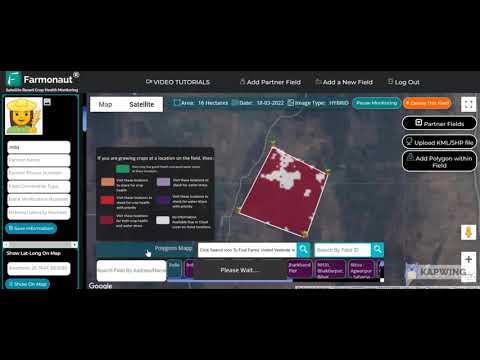Essential Farm Safety: Mastering Tractor Speed Limits and Trailer Regulations for Safer Rural Roads
“Over 90% of non-testable trailers were found defective, highlighting the critical need for regular maintenance in farm equipment.”
Welcome, farmers and agricultural professionals! Today, we’re diving deep into a crucial topic that affects every one of us working in the fields and traversing rural roads: farm safety, with a specific focus on tractor speed limits and trailer regulations. As we navigate the ever-evolving landscape of agricultural practices, it’s essential to stay informed about the latest rules and best practices that keep us safe and compliant.
At Farmonaut, we understand the importance of efficiency in farm management, but we also recognize that safety should never be compromised. While our satellite-based farm management solutions help optimize your operations, adhering to road safety regulations is equally vital for the success and sustainability of your farm business.
The Current State of Farm Equipment Safety
Before we delve into the specifics of tractor speed limits and trailer regulations, let’s take a moment to understand the gravity of the situation. Recent studies have shown alarming statistics regarding farm equipment safety, particularly when it comes to trailers:
- Over 90% of non-testable trailers were found to be defective
- A significant number of accidents on rural roads involve agricultural vehicles
- Many farmers are unaware of the latest regulations and speed limits for their equipment
These figures underscore the urgent need for increased awareness and compliance with farm equipment safety measures. As stewards of the land and vital contributors to our nation’s food supply, it’s our responsibility to ensure that our operations don’t pose unnecessary risks to ourselves or others on the road.
Understanding Tractor Speed Limits
One of the most critical aspects of farm safety on public roads is adhering to tractor speed limits. These limits are designed to ensure the safe operation of agricultural vehicles, taking into account their size, weight, and potential impact on other road users.
| Vehicle Type | Vehicle Width | Speed Limit on Public Roads | Special Conditions |
|---|---|---|---|
| Tractor | Under 2.55 meters | 40 mph | N/A |
| Tractor | Over 2.55 meters | 20 mph | N/A |
| Tractor with Trailer | Any width | 20 mph | N/A |
| Tractor with Large Implements | Any width | 20 mph | Towing large implements |
“Tractors under 2.55 meters wide have a 40mph speed limit, but this drops to 20mph when towing large implements.”
It’s crucial to note that these speed limits are maximums, and farmers should always use their judgment to determine a safe speed based on road conditions, weather, and the specific characteristics of their vehicle and load.
Trailer Regulations: A Critical Component of Farm Safety
Trailers are an indispensable part of many farming operations, but they also present significant safety challenges. The alarming statistic that over 90% of non-testable trailers were found defective highlights the urgent need for better maintenance and compliance with regulations.
Key areas of focus for trailer regulations include:
- Weight restrictions
- Proper hitching and coupling
- Lighting and reflector requirements
- Brake system functionality
- Tire condition and pressure
Regular inspections and maintenance are crucial to ensuring that your trailers meet all safety standards. This not only helps prevent accidents but also avoids potential fines and legal issues that could arise from non-compliance.
The Importance of Trailer Maintenance
Proper trailer maintenance is not just about compliance; it’s about protecting your investment, ensuring operational efficiency, and safeguarding lives. Here are some key aspects of trailer maintenance that every farmer should prioritize:
- Routine Inspections: Implement a schedule for regular checks of all trailer components, including brakes, lights, tires, and hitches.
- Brake System Maintenance: Ensure brake systems are functioning correctly and adjust as necessary.
- Tire Care: Regularly check tire pressure and tread depth, and replace worn tires promptly.
- Electrical Systems: Verify that all lights and signals are working correctly to ensure visibility on the road.
- Structural Integrity: Inspect the frame and body for any signs of wear, rust, or damage.
By incorporating these maintenance practices into your routine, you can significantly reduce the risk of equipment failure and improve overall farm safety.
Potential Changes in Tractor Driving License Requirements
As the agricultural industry evolves, so do the regulations governing it. There are ongoing discussions about potential changes to tractor driving license requirements. While no definitive changes have been implemented yet, farmers should stay informed about these potential developments:
- Possible introduction of specific tractor driving licenses
- Enhanced training requirements for operating large agricultural vehicles
- Age restrictions for operating certain types of farm machinery on public roads
These potential changes aim to improve road safety and ensure that all operators of agricultural vehicles are adequately trained and competent. As responsible farmers, it’s crucial to stay ahead of these developments and prepare accordingly.
The Tilly Campaign: Promoting Equipment Checks
An excellent initiative that’s gaining traction in the farming community is the Tilly campaign. This campaign promotes regular equipment checks and maintenance to prevent accidents and improve overall farm safety. Named after a young girl who tragically lost her life in a farm accident, the Tilly campaign serves as a poignant reminder of the importance of safety in agriculture.
Key aspects of the Tilly campaign include:
- Encouraging daily equipment checks
- Promoting a culture of safety on farms
- Raising awareness about the potential dangers of farm machinery
- Providing resources and checklists for equipment maintenance
By participating in campaigns like Tilly, we can collectively work towards creating a safer environment for everyone in the agricultural community.
Compliance and Record-Keeping: Essential for Farm Safety
Maintaining proper records is a crucial aspect of ensuring compliance with farm safety regulations. Good record-keeping practices not only help you stay organized but also provide evidence of your commitment to safety in case of inspections or audits.
Essential records to maintain include:
- Equipment maintenance logs
- Driver training certificates
- Vehicle inspection reports
- Accident reports and near-miss incidents
- Safety meeting minutes
By keeping detailed and up-to-date records, you demonstrate your proactive approach to farm safety and protect your business from potential legal issues.
Leveraging Technology for Enhanced Farm Safety
In today’s digital age, technology plays a crucial role in improving farm safety. While Farmonaut’s primary focus is on satellite-based farm management solutions, our tools can indirectly contribute to safer farming practices:
- Real-time monitoring: Our satellite imagery can help you plan safer routes for machinery movement across your fields.
- Weather forecasting: Accurate weather predictions allow you to schedule road travel during optimal conditions.
- Resource management: Efficient resource allocation can reduce the need for rushed operations, promoting safer practices.
By integrating these technological solutions into your farm management strategy, you can create a safer environment for your workers and comply with road safety regulations more effectively.
The Role of Community in Promoting Farm Safety
Creating a culture of safety extends beyond individual farms. It requires a community-wide effort to raise awareness, share best practices, and support one another in implementing safety measures. Here are some ways the farming community can come together to promote safety:
- Organizing local workshops on farm safety topics
- Sharing experiences and lessons learned from safety incidents
- Collaborating with local authorities to improve rural road conditions
- Participating in national farm safety initiatives and campaigns
By fostering a strong sense of community around farm safety, we can create a supportive environment that encourages compliance and best practices.
The Impact of Farm Safety on Business Success
While safety should always be the primary concern, it’s worth noting that implementing robust safety measures can also have a positive impact on your farm’s bottom line. Here’s how:
- Reduced downtime: Well-maintained equipment is less likely to break down, minimizing costly interruptions to your operations.
- Lower insurance premiums: Many insurance providers offer discounts for farms with strong safety records and compliance measures in place.
- Improved worker retention: A safe work environment leads to higher employee satisfaction and retention rates.
- Enhanced reputation: A commitment to safety can improve your farm’s reputation among customers, suppliers, and the local community.
By viewing safety as an investment rather than a cost, you can create a more resilient and successful farm business.
Staying Informed: Resources for Farm Safety
Keeping up with the latest regulations and best practices in farm safety is an ongoing process. Here are some valuable resources to help you stay informed:
- National farmers’ associations and unions
- Agricultural safety organizations
- Government agricultural departments
- Industry publications and newsletters
- Online forums and communities for farmers
Regularly consulting these resources can help you stay ahead of regulatory changes and learn about new safety technologies and practices.
Explore Farmonaut’s API for advanced farm management solutions
Preparing for the Future of Farm Safety
As we look to the future, it’s clear that farm safety will continue to evolve. Emerging technologies, changing regulations, and new farming practices will all shape the landscape of agricultural safety. Here are some trends to watch:
- Autonomous vehicles: The introduction of self-driving tractors and other machinery will bring new safety considerations.
- IoT sensors: Internet of Things (IoT) devices could provide real-time safety monitoring for farm equipment.
- Virtual reality training: VR technology may offer more immersive and effective safety training for farm workers.
- Blockchain for compliance: Blockchain technology could revolutionize how we track and verify safety compliance.
By staying aware of these trends and being open to adopting new technologies, we can continue to improve farm safety for generations to come.
Access our API Developer Docs for integration guidance
Conclusion: A Commitment to Safer Farming
As we’ve explored throughout this article, farm safety – particularly concerning tractor speed limits and trailer regulations – is a multifaceted issue that requires ongoing attention and commitment. By staying informed about regulations, maintaining our equipment diligently, leveraging technology, and fostering a community-wide culture of safety, we can significantly reduce risks and create a safer environment for everyone in the agricultural sector.
Remember, safety is not just about compliance; it’s about protecting our livelihoods, our workers, and our communities. Let’s work together to make our farms and rural roads safer for everyone.
FAQ: Farm Safety and Regulations
Q: What is the speed limit for tractors on public roads?
A: The speed limit for tractors varies depending on the vehicle’s width and whether it’s towing a trailer. Tractors under 2.55 meters wide have a 40mph limit, while those over 2.55 meters or towing trailers are limited to 20mph.
Q: How often should I inspect my farm trailer?
A: It’s recommended to perform a visual inspection before each use and conduct a thorough inspection at least once a month or as specified by the manufacturer.
Q: Are there any upcoming changes to tractor driving license requirements?
A: While there are discussions about potential changes, no definitive new requirements have been implemented yet. It’s important to stay informed about any updates from your local agricultural authority.
Q: What records should I keep for farm safety compliance?
A: Essential records include equipment maintenance logs, driver training certificates, vehicle inspection reports, accident reports, and safety meeting minutes.
Q: How can technology improve farm safety?
A: Technology like Farmonaut’s satellite-based solutions can help with efficient resource management, route planning, and weather forecasting, indirectly contributing to safer farming practices.








